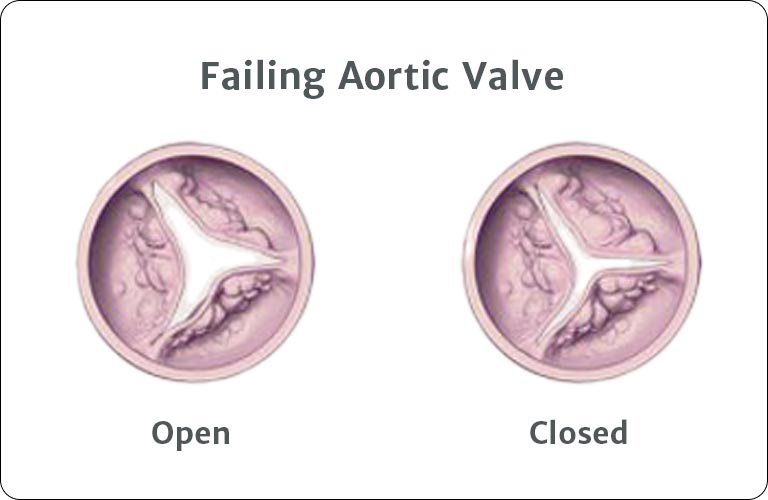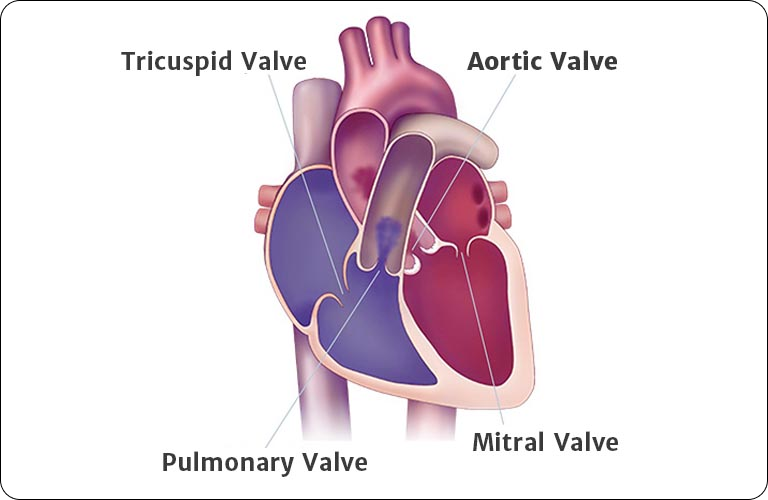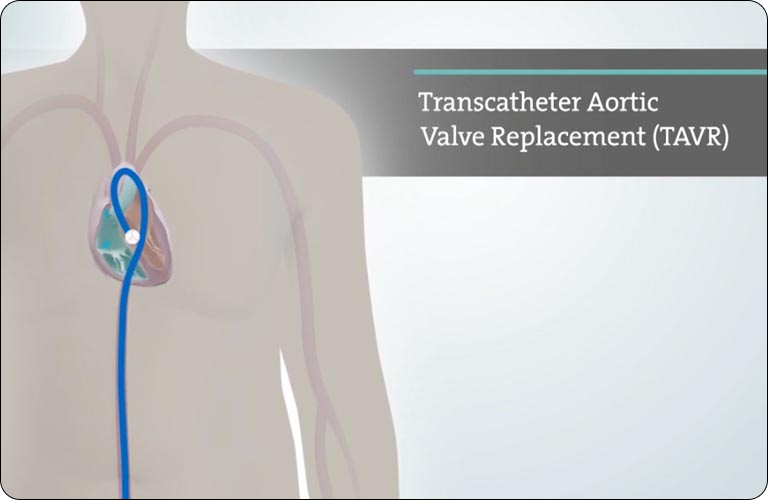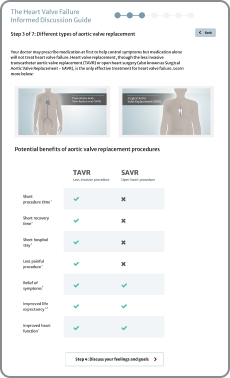Frequently Asked Questions
Have questions about aortic stenosis, also known as heart valve disease? We have answers.
Discover how to live life on your terms. Start by getting answers to your questions about diagnosis and treatment options once your heart valve disease becomes severe and you experience symptoms, which is also known as heart valve failure. Explore our frequently asked questions below and get the information you need to take control of your future.
About heart valve disease
What is heart valve disease?
Aortic stenosis, the most common type of heart valve disease, is a serious condition that impacts the heart health of millions of Americans. This progressive condition is caused by a narrowing of the aortic valve, which prevents normal blood flow. Because the condition gets worse with time, doctors will measure it as mild, moderate, or severe (depending on how damaged the valve is).
What causes heart valve disease?
There are 4 main causes of aortic stenosis, one type of heart valve disease: calcium buildup on the valve leaflets, birth defects that may impact the structure of the aortic valve, rheumatic fever which can cause scar tissue to form in the heart, and radiation therapy.
What does it mean if you have heart valve disease with a bicuspid aortic valve?
A normal aortic valve has three thin leaflets that open and close when the heart beats to regulate blood flow. About 1% to 2% of people are born with a bicuspid aortic valve, meaning it only has two leaflets. Bicuspid only refers to the number of leaflets within your heart valve and not to the disease itself.
Is heart valve disease different if you have a bicuspid aortic valve?
No. The only difference is the number of leaflets the aortic valve has. Aortic stenosis, a type of heart valve disease, is the stiffening of your aortic valve (regardless if you have two or three leaflets), which causes a narrowing of the aortic valve opening. This means the valve cannot fully open and close like it should. The amount of blood pumped with each beat of your heart is reduced, so it’s forced to work harder to supply your body with the blood it needs.
About heart valve failure
What is heart valve failure?
Aortic stenosis is one type of heart valve disease, and if it goes untreated, it will progress to the severe stage. When you have symptoms at this severe stage, it is known as heart valve failure. This means the aortic valve has severe build-up of calcium and has a difficult time opening and closing. Your heart may need to work harder to pump blood throughout your body.
What are the symptoms of heart valve failure?
Symptoms of heart valve failure include shortness of breath, chest pain, fatigue, lightheadedness, rapid or irregular heartbeat, swollen ankles/feet or difficulty exercising. These symptoms may indicate your heart valve failure has progressed to a life-threatening point.
How serious is heart valve failure?
Severe symptomatic aortic stenosis, also known as heart valve failure, is serious, which is why treatment is important. You may have also heard it referred to as severe aortic valve stenosis. Up to 50% of people who develop heart valve failure will die within an average of 2 years of symptom onset if they do not have their aortic valve replaced.2 If you’ve been told you have severe aortic stenosis (heart valve failure), don’t wait until the disease completely disrupts your life before treating it.
Diagnosis and treatment of heart valve failure
What are the treatment options for heart valve failure?
Depending on how far your aortic stenosis, the most common type of heart valve disease, has progressed, your doctor may prescribe medication to help control your symptoms. But it is important to remember: the disease cannot be fixed with medication alone and will continue to get worse until you treat it. This can be done through transcatheter aortic valve replacement (TAVR) or open heart surgery.
What treatment options are available for heart valve failure if you have a bicuspid aortic valve?
Both TAVR and open heart surgery may be treatment options for bicuspid patients. However, only a TAVR Heart Team can determine which treatment option is best for the patient. Those with severe symptomatic aortic stenosis, also known as heart valve failure, of their bicuspid aortic valve, should seek an evaluation with a TAVR Heart Team to see all treatment options available for them.
About Transcatheter Aortic Valve
What is TAVR (Transcatheter Aortic Valve Replacement)?
TAVR (also known as transcatheter aortic valve implantation or TAVI for short) is a less invasive procedure for replacing a diseased aortic valve. During the procedure, your TAVR Doctor will use a catheter to implant a new valve within your diseased valve. TAVR can be performed through multiple approaches; however, the most common is through a small incision in the leg. TAVR procedures can be performed under conscious sedation, rather than general anesthesia.
What are the different approaches used to perform TAVR?
TAVR can be performed in different ways depending on each individual’s anatomy.
Some approaches include:
- The transfemoral approach (the most common approach and is through an incision in the leg).
- The subclavian approach (through an incision near the shoulder).
- The transapical approach (through an incision in the chest between the ribs).
- The transaortic approach (through an incision in the upper chest).
Does my heart have to be stopped for TAVR?
No, unlike open heart surgery, TAVR does not require stopping the heart.
How could I benefit from a transcatheter valve replacement?
With the less invasive TAVR procedure, people may be able to return to daily activities sooner than with open heart surgery. Some people who undergo TAVR get back to life quicker and report improved quality of life following the procedure. Other TAVR benefits may include: shorter hospital stay, relief of symptoms, improved heart function, and reduced pain and anxiety.3
How long is the TAVR procedure?
Depending on your health and the procedural approach recommended by your doctor, the average TAVR procedure lasts approximately 1 hour. In comparison, the average open heart surgery lasts approximately 4 hours.3
What is TAVI, and is it different from TAVR?
TAVI stands for transcatheter aortic valve implantation. The procedure and its approaches are the same as TAVR. Your doctor may use the terms interchangeably when discussing your treatment options.
How long have TAVR procedures been performed?
TAVR has been commercially available in Europe since 2007 and in the United States since 2011.
How many people have had the TAVR procedure?
Edwards TAVR (SAPIEN platform of Valves) has treated over 1 million patients worldwide.
Are there different types of transcatheter heart valves and can I ask for a specific valve?
Transcatheter heart valves are made by different manufacturers. You can check which valves are used and available at your hospital. Although you can ask for a specific valve, your TAVR Doctor will recommend the best valve for you.
Learn More About Edwards Transcatheter Heart Valves
Does my insurance cover TAVR and do I need a referral?
You should contact your insurance carrier directly prior to your first appointment with your TAVR Doctor to determine if your TAVR evaluation and TAVR procedure are covered, and if a referral is required.
The Centers for Medicare and Medicaid Services (CMS) cover TAVR under certain conditions. You can learn more by visiting our Helpful Websites page.
Learn More on Our Helpful Websites Page
What are the potential risks or complications of TAVR?
The most serious risks of TAVR include death, stroke, serious damage to the arteries, or serious bleeding. For detailed risk information, click "Important Risk Information" at the bottom of this page. It is important to talk to your doctor about any questions or concerns you may have.
Is TAVR approved to treat patients who have bicuspid severe aortic stenosis (heart valve failure)?
Yes, TAVR may be an option for patients with a bicuspid aortic valve. Open heart surgery is not their only option (although it may be the best option for their unique situation). Only a TAVR Heart Team can determine which treatment option is best for the patient. Those with bicuspid severe symptomatic aortic stenosis, also known as heart valve failure, should seek an evaluation with a TAVR Heart Team to see all treatment options available for them.
Getting a TAVR evaluation
How do I know if TAVR is right for me?
All patients diagnosed with severe aortic stenosis, also known as heart valve failure, who are experiencing symptoms should be evaluated for all of their valve replacement options, including TAVR. The American College of Cardiology and American Heart Association have recently updated the guidelines for treatment of severe aortic stenosis. If you were told that TAVR was not an option for you in the past, you may be eligible now.
You need to be evaluated by a TAVR Doctor, who is part of a larger Heart Team, at a TAVR Hospital to determine if it is an option for you. You can use our Find a TAVR Hospital tool to identify the nearest location to you.
What tests will be done to determine if TAVR is right for me?
One or more of the following tests may be used to determine if TAVR is the best option for you.
- Chest X-ray: A type of imaging to view images of the organs and structures inside your chest. You will be placed between a metal plate and the X-ray machine. The X-ray technician will take several images of your chest in a variety of positions. This may take up to 30 minutes to perform.
- Transthoracic echocardiogram (TTE): This diagnostic test (also known as an echo) uses ultrasound to obtain 3D images of the heart. While you are lying on a table, a probe will be placed on your chest wall and will use sound waves to provide detailed pictures of your heart. This usually takes approximately 20 minutes.
- Magnetic resonance imaging (MRI): A diagnostic test that uses magnetic and radio waves to take detailed pictures of your heart. You will be asked to lie down on a bed that moves into a large tube. You won’t feel anything but will hear a noise as the images are acquired. You will be asked to lie very still for duration of test. This usually takes 30-90 minutes.
- Pulmonary function test (PFT): A group of tests, using special breathing equipment, that will measure how well your lungs are moving oxygen to the blood. These can take 60-120 minutes.
- Computerized tomography (CT) scan: An imaging test that uses X-rays to obtain detailed pictures of your heart and blood vessels. You will be injected with contrast dye through an IV. You will be asked to lie down on a bed that passes through a donut-shaped X-ray scanner to take clear images of your heart. This takes up to 60 minutes.
- Angiogram (cardiac cath): An imaging test that uses X-ray and dye to see how blood flows through your arteries and veins. You will lie on your back on an X-ray table. A small incision will be made and a small tube, called a catheter, will be inserted either in your groin or near your elbow. Dye will be injected into the vessel to make the area show clearly on the X-ray pictures. This takes up to 60 minutes.
- Transesophageal echocardiogram: A test that obtains detailed pictures of your heart by inserting a probe down the esophagus (throat). While lying on a table, a technician will spray your throat with medicine to numb and suppress your gag reflex. A thin flexible tube will be guided down your throat. The probe will send and receive sound waves which will become pictures on a video screen. This may take up to 90 minutes.
Is TAVR only for people who are too sick or for whom surgery is too risky?
More people are eligible for TAVR than ever before. TAVR may be an option for anyone with severe symptomatic aortic stenosis, also known as heart valve failure. Only a specialized TAVR Heart Team can tell you if TAVR is right for you.
How can I get evaluated for TAVR?
To see if the TAVR procedure is right for you, you need to seek out expert care at a TAVR Hospital from a Heart Team that includes a specialized heart doctor called an interventional cardiologist (also referred to as a TAVR Doctor). Only a Heart Team at a TAVR Hospital can evaluate you for both TAVR and open heart surgery to determine what the best treatment option is for you.
Not all hospitals perform TAVR, but you can find the nearest TAVR Hospital using the Find a TAVR Hospital Tool.
What is a Heart Team?
You may have heard the term Heart Team while researching your severe symptomatic aortic stenosis (heart valve failure) treatment options. A Heart Team is a specialized care team that includes interventional cardiologists (TAVR Doctors), cardiothoracic surgeons, imaging specialists, anesthesiologists, cardiac cath lab staff, and a cardiologist. Together, the specialized Heart Team will conduct a comprehensive evaluation to determine whether the TAVR procedure is appropriate for you.
What is a Valve Clinic Coordinator (VCC)?
A VCC is usually your first point of contact at a TAVR Hospital. They are in charge of coordinating all activities regarding TAVR. The VCC provides support to patients from referral to a TAVR Doctor through follow-up from the TAVR procedure. They will help you navigate through the process of evaluation, possible treatment, insurance coverage, and financial needs.
What if my doctor doesn’t know about TAVR or perform TAVR?
If your doctor doesn’t perform TAVR, you should ask for a referral to a TAVR Hospital. The doctors at a TAVR Hospital are experts in valvular disease and valve replacement and are able to determine the best treatment option for you. Find the nearest TAVR Hospital.
What if my doctor does not think I am a good candidate for TAVR?
TAVR is becoming an option for more and more people with severe symptomatic aortic stenosis, also known as heart valve failure. If your doctor does not think you are a good candidate for TAVR, you may still contact a TAVR Hospital to receive a second opinion.
Recovery from TAVR
What should I expect directly after my TAVR procedure?
Often with TAVR, there is less downtime. Typically following a TAVR procedure, you may be taken to the intensive care unit (ICU) for a little while or moved directly to a recovery room. Your doctor will update your caregiver or loved ones on how you are doing.
How long will I be in the hospital for my TAVR procedure?
With TAVR, most patients return home the next day and have a shorter recovery time, getting them back to everyday activities.
What does life after TAVR look like?
Research has shown patient health improvements within 30 days, including the ability to take care of themselves and participate in everyday activities.3
How long does a transcatheter heart valve last?
How long your tissue valve will last depends on many patient factors and medical conditions. Follow all care instructions to ensure the best possible results. The Edwards transcatheter valve has been tested in a laboratory to mimic 5 years of use without failure. Regular follow-ups will help your doctor know how your valve is working.
What happens if my transcatheter heart valve fails?
Every year after TAVR you should have a follow-up appointment with your cardiologist, who will be checking your heart. During these visits, your cardiologist will likely perform an echocardiogram and complete other tests to make sure your valve and heart are still working properly. If your cardiologist determines that your valve is no longer working the way it should, your doctor will determine next steps and decide if you need an evaluation for reintervention. If it is determined that another procedure is needed to fix your failing heart valve, and you have previously had a transcatheter heart valve for your severe symptomatic aortic stenosis (heart valve failure), you could be eligible to get another transcatheter heart valve placed into your failed artificial valve. This procedure is known as valve-in-valve and may be an option for patients who are deemed high risk for open heart surgery.
About open heart surgery
What is open heart surgery?
Open heart surgery for aortic valve replacement is where the doctor will open your chest and will completely remove the damaged valve and replace it with an artificial valve. You will be connected to a heart-lung machine that does the work of your heart and keeps the blood flowing throughout your body. Patients usually need to stay in the hospital for a week or more.
How long does it take to recover from open heart surgery?
After open heart surgery, it can take the body a long time to recover. Your chest needs to be opened during the operation, and it can take several months to heal completely. Cardiac care rehabilitation is recommended.
What are the potential risks or complications of open heart surgery?
The most serious risks of open heart surgery include death, stroke, infection and bleeding.
What happens if my surgical heart valve fails?
During your routine checkups with your cardiologist, you will likely have an echocardiogram and complete other tests to make sure your valve and heart are still working properly. If your cardiologist determines that your valve is no longer working the way it should, your doctor will determine next steps and decide if you need an evaluation for reintervention. If it is determined that another procedure is needed to fix your failing surgical heart valve, you may be eligible to get a transcatheter heart valve placed into your failed surgical valve. This procedure is known as valve-in-valve and may be an option for patients who are deemed high risk for another open heart surgery.
Patient resources for heart valve failure and TAVR
Are there resources available to better understand heart valve failure and treatment options?
There are many free patient resources to help you manage your health and educate loved ones about severe symptomatic aortic stenosis, also known as heart valve failure, and treatment options, including patient stories, brochures and procedure videos. A personalized information kit is also available to help answer your questions on heart valve failure and TAVR.
Are there support groups or other helpful websites I can visit for more information?
There are a variety of helpful websites that may provide additional information on diagnosis and treatment of severe symptomatic aortic stenosis, also known as heart valve failure, as well as support services. Visit our helpful websites page to learn about these available resources.
Learn more on our helpful websites page
How can I find a TAVR Hospital near me?
You can search for TAVR Hospitals by zip code, city/state, or by hospital name using our Find a TAVR Hospital tool. Once you find a TAVR Hospital near you, you may click on the provider to view listing details.
References
1. Osnabrugge RL, Mylotte D, Head SJ, et al. Aortic stenosis in the elderly: disease prevalence and number of candidates for transcatheter aortic valve replacement: a meta-analysis and modeling study. J Am Coll Cardiol. 2013;62(11):1002-1012.
2. Otto C. Timing of aortic valve surgery. Heart. 2000;84(2):211-218.
3. PARTNER 3 trial, low-risk cohort unadjusted clinical event rates, AT population.






 Australia
Australia
 Brazil
Brazil
 Canada - French
Canada - French
 China - Taiwan
China - Taiwan
 Denmark
Denmark
 Finland
Finland
 Germany
Germany
 Italy
Italy
 Netherlands
Netherlands
 New Zealand
New Zealand
 Norway
Norway
 South Korea
South Korea
 Southeast Asia
Southeast Asia
 Sweden
Sweden
 United Kingdom
United Kingdom
 United States
United States